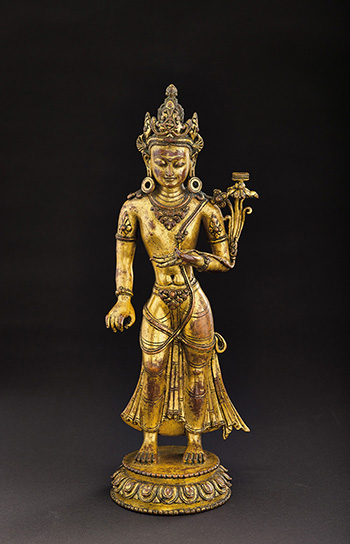PROVENANCE:
Collection Mr J. Gelpey, London, before 1997
Collection Spink and Son Ltd, London, 1997-2002
Collection Mr and Mrs. J. Meijer, the Netherlands, 2002-2013
PUBLISHED:
Catalogue Note
A VERY RARE AND IMPORTANT GILT BRONZE FIGURE OF MANJUSHRI
The bodhisattva stands in a graceful posture, abbanga, on a circular lotus pedestal, holding the stem of a flower in his left hand. The Prajnaparamita text, ‘Perfection is Wisdom’, resting on the lotus bloom at the shoulder identifies the subject as Manjushri, the Buddhist god of Wisdom. Although the statue was probably cast in Tibet for a Tibetan patron, there is no mistaking the influence of Napalese sculptural traditions in the sensuous modelling of the youthful human form and the stem yet engaging expression. The sash tied low at the left thigh is a feature commonly seen on Nepali standing bodhisattvas. And the gilt copper from which it is made is particularly reminiscent of Nepalese statues. Subtle departures from mainstream Nepalese styles, however, suggest the Tibetan provenance. The large pectoral suspended from the necklace, the similarly shaped but smaller belt ornaments, and the rhomboid jewellery set above the armbands, are designs not seen on contemporary Nepalese sculpture. Numerous historical records confirm the presence of Newar artists in Tibet, who were no doubt influential in the creation of this elegant sculpture of Manjushri. Another Bodhisattva Kyabdol (skyab sgrol) with an ear of corn at his left shoulder (in the collection of the British Museum, fig.1) corresponds very closely in style to Spink’s Manjushri. Since both deities belong to the iconographic group of 16 Bodhisattvas it is likely that the two images originally belonged to the same set.
